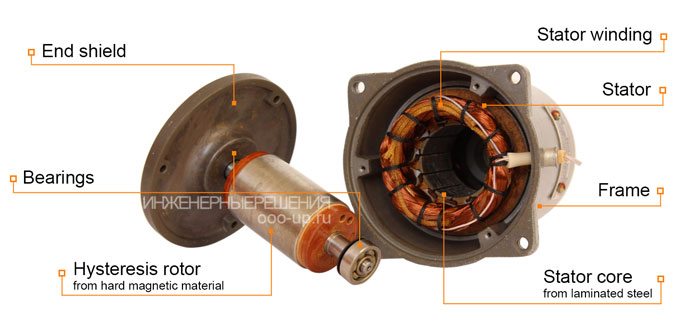Hysteresis motor
The construction of hysteresis motor
A synchronous hysteresis motor, like any rotating electric motor, consists of a rotor and a stator. The stator is the fixed part. The rotor is the rotating part.
The stator of a hysteresis motor has a conventional three- or two-phase winding, which creates a rotating magnetic field, and the rotor is a massive cylinder without a winding, made of hard magnetic material with a wide hysteresis loop (for example, an alloy Vicalloy). At the same time, in order to save expensive magnetically hard material, the rotor is made assembled.
Working principle of hysteresis motor
The principle of operation of the synchronous hysteresis motor is based on the action of the hysteresis torque. For clarity, the figure below shows only two elementary magnets ns 1 and 2. The interaction force between these magnets and the stator field NS is directed along the axis of the latter (left figure). If the NS field to turn, for example, counterclockwise, then elementary magnets turn in the same direction. However, due to the magnetic hysteresis, the magnets ns will not immediately turn to the same angle as the NS field. Some mismatch angle γ will appear between the NS and ns axes. In addition to the radial forces, tangential forces appear (right figure), which will create the hysteresis torque Мh. The angle γ is determined by the shape of the hysteresis loop of the material from which the rotor is made.
The hysteresis torque Mh does not depend on the rotor speed. A radical way to increase the torque of a hysteresis motor is the use of hard magnetic materials with a rectangular hysteresis loop. The rotational speed of such motor is synchronous with rotational frequency of the field, the efficiency is high - up to 80% [2].
The phenomenon of magnetic lag is that particles of the ferromagnetic material of the rotor, which are elementary magnets, tend to be oriented in accordance with the direction of the external magnetic field. If the external magnetic field changes its direction, then the elementary particles also change orientation. However, molecular friction forces impede the rotation of elementary particles in magnetically hard material. This explains the appearance of the shear angle γ, the value of which depends on the magnetic properties of the rotor material [3].
Due to the massive rotor design, hysteresis motors also develop eddy current torque at start-up. However, this torque is much less than the hysteresis torque, as a result of which the start-up, as well as drawing into synchronism and operation, occurs due to the hysteresis torque. When the motor runs at synchronous speed torque due to eddy current losses vanish.
The difference between permanent magnet motors and hysteresis motors is that in the first the rotor is subjected to a special preliminary magnetization, and in the second it is magnetized by the stator field of the motor. Hysteresis motors have better performance than reluctance motors and designed with power up to 300 ... 400 watts.
Advantages and disadvantages
The advantages of hysteresis motors are the simplicity of the device, the reliability of operation, the absence of starting devices, the smoothness of synchronization, the almost constant current during start-up and operation. The disadvantages include the relatively high cost of the rotor material, although, as a rule, the rotor is made of ordinary steel and only a small hollow cylinder from a hard magnetic material is placed on it.
- GOST 27471-87 Rotating electrical machines. Terms and definitions.
- N.I.Volkov, V.P.Milovzorov. Electromachine devices of automatics: A textbook for universities.- Second edition.- Мoscow: 1986.
- M.M.Katsman. Electrical machines and electric drive of automatic devices: A textbook for electrical engineering technical schools. - Moscow: 1987.

